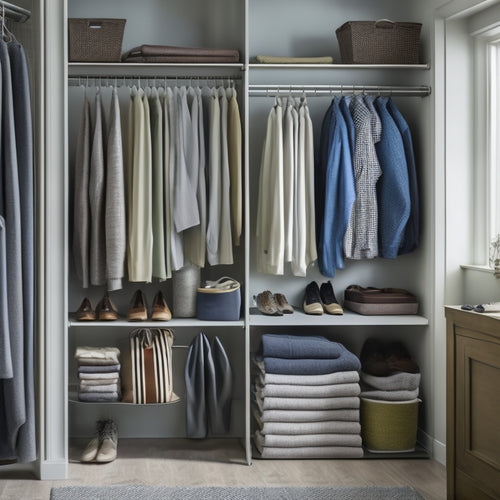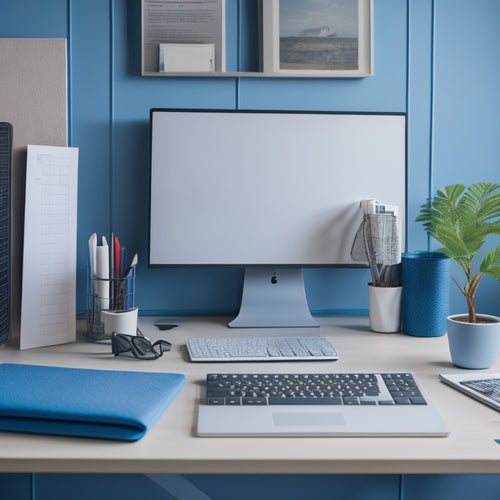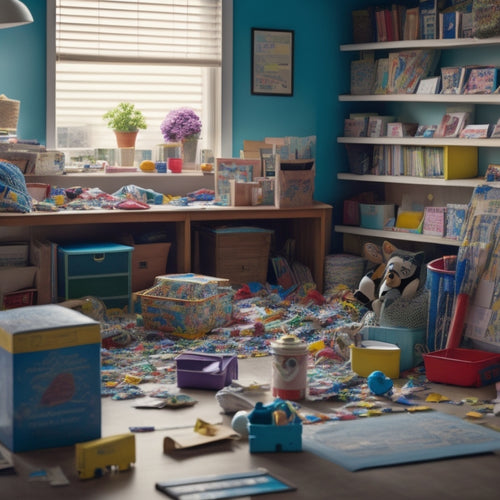
Creating a Dream Home Office Organization System
Share
You're ready to transform your home office into a productivity hub! Start by evaluating your needs: identify frequent tasks, time-consuming activities, and areas where you lose focus. Categorize your storage needs into essential, occasional, bulky, delicate, and archival items, and set a realistic budget. Next, design a custom storage plan that maximizes vertical space, utilizing shelves, hooks, and dividers to keep items organized and easily accessible. Create a functional workstation with an ergonomic chair, efficient workflow, and minimized walking distances. Now, get ready to tame paperwork, incorporate ergonomic essentials, and maintain your new system - and discover the secrets to a truly dream home office organization system that takes your productivity to the next level.
Key Takeaways
• Identify tasks performed frequently and prioritize storage needs to create a functional and organized office space.
• Maximize vertical space and storage options by installing shelves, hooks, or pegboards and using hidden compartments for sensitive items.
• Implement a 'touch once' policy for paperwork clutter and set up an easily accessible filing system with labeled folders to reduce paper clutter.
• Create a functional workstation by selecting an ergonomic chair, arranging the workspace for efficient workflow, and using a desk organizer for frequently used items.
• Allocate daily time for tidying up the workspace and conduct quarterly reviews to evaluate system effectiveness and make adjustments as needed.
Assessing Your Home Office Needs
Before you can create a dream home office organization system, you need to take stock of your workspace and habits to identify what's working and what's not. Start by evaluating how you spend your time and appraising your current office layout.
Take a week or two to observe your daily routine, noting how you move around the space, what tasks you perform, and how often you use specific areas or tools. This will help you identify your Task Priorities and Workflow Patterns.
Ask yourself:
- What tasks do you perform most frequently?
- What're your most time-consuming tasks?
- Where do you tend to get stuck or lose focus?
Make a list of your top priorities and the tasks that support them. Then, assess your office layout, considering the 'zones' you've created and how they support your workflow. Are there any bottlenecks or inefficiencies in your current setup?
Designing a Custom Storage Plan
With your task priorities and workflow patterns in mind, you can now start designing a custom storage plan that allocates space and resources efficiently, ensuring that everything you need is within easy reach. A well-planned storage system will help you stay organized, focused, and productive.
To get started, consider the items you need to store and the space you have available. Think about the frequency of use and the size of each item. You may want to categorize your storage needs into two groups: essential items and occasional items.
| Storage Needs | Storage Solution |
|---|---|
| Essential Items (e.g., laptop, papers) | Custom Cabinets with easy access |
| Occasional Items (e.g., files, office supplies) | Shelving Units or Bookcases |
| Bulky Items (e.g., printer, scanner) | Floor-standing Cabinets or Shelves |
| Delicate Items (e.g., artwork, fragile decor) | Glass-front Cabinets or Display Cases |
| Archival Items (e.g., documents, records) | Filing Cabinets or Storage Bins |
When designing your custom storage plan, remember to set a realistic storage budget and prioritize your needs. By allocating space and resources efficiently, you'll be able to create a functional and organized home office that meets your unique needs.
Maximizing Vertical Space Options
When maximizing vertical space in your home office, you should contemplate installing wall-mounted storage solutions to keep frequently used items within easy reach.
You'll also need to think about shelf dividers to keep your stored items organized and prevent clutter from building up.
Wall Mounted Storage
You can amplify your wall-mounted storage capabilities by installing shelves, hooks, or a pegboard. This will help you maximize the often-underutilized vertical space in your home office.
This will enable you to store more items, keeping your workspace clutter-free and organized. Consider incorporating hidden compartments to stash sensitive documents or valuable items, keeping them out of sight but still accessible.
Adjustable shelves are another great option, allowing you to customize the storage space to fit your specific needs. For instance, you can adjust the shelf height to accommodate large binders or stackable storage bins.
When choosing wall-mounted storage solutions, think about the types of items you need to store and how frequently you'll need to access them. This will help you determine the best type of storage solution for your specific needs.
Shelf Dividers Needed
To guarantee that your wall-mounted shelves remain organized and easy to navigate, adding shelf dividers is essential for separating and categorizing your stored items. Without dividers, your shelves can quickly become cluttered, making it difficult to find what you need when you need it. By incorporating shelf dividers, you'll be able to create distinct sections for different types of items, keeping your workspace organized and efficient.
When selecting shelf dividers, consider the following factors:
-
Shelf Styles: Choose dividers that complement your shelf style, whether it's modern, traditional, or minimalist.
-
Divider Materials: Select dividers made from durable materials, such as wood, metal, or plastic, to make certain they can withstand the weight of your stored items.
-
Adjustability: Opt for dividers that are adjustable, allowing you to customize the width of each section to fit your specific needs.
Creating a Functional Workstation
Now that you've optimized your vertical space, it's time to focus on creating a functional workstation that boosts your productivity and comfort.
You'll want to prioritize an ergonomic chair that provides adequate support, thoughtfully arrange your workspace to minimize distractions, and select desk accessories that streamline your workflow.
Ergonomic Chair Essentials
As you create a functional workstation, don't overlook the importance of a well-designed ergonomic chair.
A well-designed ergonomic chair serves as the foundation of a functional workstation, providing excellent support and comfort for your body while you work. With comfort as your priority, you'll be more focused and productive throughout the day.
Here are three essential features to contemplate when selecting an ergonomic chair:
-
Adjustable Seat Height: Contemplate that the chair allows you to adjust the seat height to fit your body, with your feet flat on the floor or on a footrest, and your knees at or below hip level.
-
Lumbar Support: Look for a chair with a curved backrest that supports the natural shape of your spine, reducing strain on your lower back.
-
Armrest Adjustability: Choose a chair with armrests that can be adjusted in height, width, and angle to support your arms and shoulders in a neutral position.
Workspace Layout Considerations
With your ergonomic chair in place, consider the overall workspace layout to guarantee a seamless workflow, efficient use of space, and reduced distractions. Think about the room's flow and how you'll move around your workspace.
Identify the areas that require the most attention, such as your computer, paperwork, and storage. Arrange these zones in a way that minimizes walking distances and promotes a smooth workflow.
Be mindful of corner challenges, where clutter tends to accumulate. Utilize corner shelves, baskets, or carousels to keep items organized and easily accessible. Consider a U-shaped workstation or an L-shaped desk to maximize corner space.
When planning your layout, keep frequently used items within easy reach to reduce distractions and increase productivity. Leave enough space between your chair and desk to accommodate your legs and move comfortably.
Optimal Desk Accessories
You'll want to strategically select and position desk accessories to create a functional workstation that streamlines your workflow and boosts productivity. A well-organized desk can help you stay focused and efficient, while a cluttered one can lead to distractions and wasted time. When choosing desk accessories, take into account the tasks you perform most frequently and the items you need within easy reach.
Here are three essential desk accessories to take into account:
-
Desk Organizer:
A desk organizer can help keep frequently used items, such as paper clips, pens, and sticky notes, tidy and organized. Look for one with separate compartments to keep similar items together. -
Cable Management System:
A cable management system can keep your workspace clutter-free by hiding unsightly cords and cables. This can also help reduce distractions and improve the overall aesthetic of your desk decor. -
Task Lamp:
A task lamp can provide focused lighting on specific areas of your workspace, reducing eye strain and improving visibility. Choose a lamp with adjustable arms to direct light exactly where you need it.
Taming the Paperwork Beast
Create a 'touch once' policy to tackle paperwork clutter by dealing with each document as soon as you touch it, either by filing, tossing, or taking action on it. This approach saves time in the long run and reduces the likelihood of paperwork piling up.
Next, establish paperwork priorities by categorizing documents into urgent, important, and non-essential. Focus on tackling the most critical ones first, and then move on to less pressing tasks.
Filing frustrations can be alleviated by setting up a logical and easily accessible filing system. Use labeled folders and categories that make sense to you, so you can quickly locate the documents you need.
Consider digitizing paperwork to free up physical storage space and reduce clutter. Scan or upload documents to cloud storage, and set up automatic backups to make sure your files are secure.
Incorporating Ergonomic Essentials
About 90% of your workday is spent sitting, making ergonomic essentials an essential component of your dream home office setup. As you spend hours on end in front of your computer, it's important to prioritize your physical comfort and well-being. Failing to do so can lead to chronic pain, fatigue, and decreased productivity.
To create an ergonomic haven, focus on the following must-haves:
-
Ergonomic Chair: Invest in a chair that provides adequate lumbar support, adjustable height, and a breathable fabric. This will help you maintain an Ergonomic Posture, reducing strain on your back and neck.
-
Properly Positioned Monitor: Make sure your monitor is at a comfortable distance, directly in front of you, and at a height that allows you to gaze slightly downward. This will help you avoid straining your eyes and neck.
-
Comfortable Keyboard Tray: Position your keyboard and mouse in a way that keeps your wrists straight and your elbows at a 90-degree angle. This will help you stay within your Comfort Zones, reducing the risk of repetitive strain injuries.
Maintaining Your New System
Establishing habits is vital for maintaining your dream home office organization system, guaranteeing that your space remains functional and clutter-free over time. To achieve this, focus on habit formation by incorporating small, daily rituals into your routine.
For instance, allocate 10-15 minutes each day to tidy up your workspace, putting away items that are no longer needed. This simple habit will help maintain the organization you've worked so hard to achieve.
Regular system evaluation is also essential to make sure your organization system continues to meet your evolving needs. Schedule quarterly reviews to assess what's working and what areas need improvement.
Ask yourself questions like:
- Are there any bottlenecks in my workflow?
- Are there any new tasks or projects that require adjustments to my system?
By regularly evaluating your system, you'll be able to make adjustments and fine-tune your organization to maximize productivity and efficiency.
Frequently Asked Questions
How Do I Stay Motivated to Maintain My New Organization System?
To stay motivated, you craft a clever commitment plan, securing an accountability partner to check in with regularly, and focus on forming habits that foster a sense of accomplishment, driving you to maintain your new system.
Can I Still Have a Decorative Home Office With Organized Clutter?
You can absolutely have a decorative home office with organized clutter; strike an aesthetic balance by blending functional storage with visually harmonious decor, ensuring your space is both beautiful and functional.
What if I Have Limited Budget for Organization Tools and Furniture?
You can still achieve an organized space on a limited budget by getting creative with DIY hacks and thrifty solutions, like repurposing items you already own, shopping second-hand, and using affordable storage containers.
How Do I Organize Digital Files and Computer Cords Effectively?
You're like Sarah, who spent hours searching for a single file on her cluttered computer. To avoid this, you'll love using cloud storage like Google Drive or Dropbox for easy access to files, and cable management systems like cord organizers or zip ties to keep cords tidy.
Can a Home Office Organization System Work for a Small, Shared Space?
You can optimize a small, shared space by incorporating space savers like wall-mounted shelves and multi-functional furniture, allowing you to work efficiently while keeping clutter at bay.
Related Posts
-

Why Double Rods Are Key to Small Closet Organization
By installing double rods, you can instantly double your storage capacity and open up a more organized, clutter-free ...
-

Master Home Organization With These 5 Online Courses
You're about to gain control over your living space with an all-inclusive education in home organization, courtesy of...
-

What's the Best Home Organization System for ADHD?
You need a home organization system that acknowledges your unique brain chemistry and works with your ADHD, not again...


